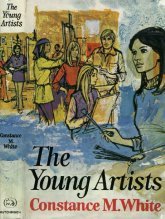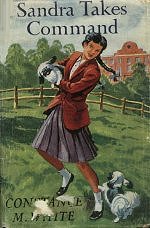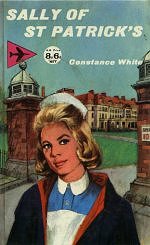Constance White and her Books by Sue
Sims
Constance White - not a name to conjure with in the school story field, certainly. You won’t find anyone boasting about picking up a first edition in d/w of Sandra Takes Command for only £20 at a book fair; it is unlikely that she will ever have a fan club in her honour. Nevertheless she is an interesting subject for three reasons. First, between 1939 and 1972 she wrote over 40 books, most of them good, workmanlike children’s fiction, which include 16 girls’ school stories. Second, she exemplifies the change which came over girls’ fiction between the 50s and the 70s. And last - but by no means least - she is still alive at the age of 91, as sharp as a woman half her age, and happy to talk about her life and her books. Constance Mary Lockett was born on November 2nd 1903 in Croydon. Her father worked at the City headquarters of a large firm of haberdashers, I & R Morley; he was "Head of the Counting House", and Constance remembers him leaving for East Croydon Station every morning clad in his frock coat and top hat. The family kept a general maid, but four children cost a fair amount to keep and educate: Arthur and Maria were respectively four and two years older than Constance, and Gordon was five years younger. Her childhood was secure and happy, despite three serious attacks of illness (scarlet fever, measles and double pneumonia) which landed her in an isolation hospital for some time. Her parents were devout Baptists, though Constance now would not class herself as "religious". Till eleven she was at a small private school; then she moved on to Croydon Secondary School (now Selhurst Grammar School). Her love of writing showed early on: she and her friend Gwen started a form magazine (a very school story thing to do!) and wrote part at least of a school story modelled on Angela Brazil, whose books were best-sellers at the time. Nevertheless, her real love was art, and when she reached 16 she begged to be allowed to go to Art School. Her request was granted, and she studied at Art School for a time, but, to quote Constance, her parents "chickened out"; a daughter who would not be earning for goodness knows how long wasn’t a particularly tempting prospect. At 16 she became an apprentice colourist, earning the princely sum of 2/6 a week after 6 months . After two years, the colourist married, and Constance, though still technically an apprentice, took over her position: ten hours a day with one afternoon off a week, and extra work during the Christmas season. It seems desperately hard work by today’s standards: "but in those days you hardly ever complained; I thought I was fortunate, and earning reasonably well. I was envious of my sister - she was a teacher, and had lovely long holidays." At 22, she married Henry Victor White (always known by his middle name), an estate agent with offices in Thornton Heath. Their only daughter, Jeanette, was born in 1925. Once Jeanette started school, Constance’s love of writing re-emerged and she began to wonder whether she could work from home as a writer. Victor was fairly unsympathetic, but Constance had her way, and took the Regent Institute Writing Course, which she says was quite helpful. She must be one of the few people to have had her assessment article, a humorous piece on painting photos, published - the Institute liked it so much that they advised her to send it to a magazine, and she sold it to the Boy’s Own Paper for a guinea! Her real writing career, though, started (as so often with parents of young children) with a sequence of bedtime stories told to her daughter about three children, and their adventures. Jeanette loved it, and continually asked for more stories about the adventurous three. Constance gradually wrote these stories down, and then took the plunge; she wrapped up the incomplete manuscript in brown paper, and sent the parcel to Harrap, with a note saying "If you like it, I’ll finish it". They did - so she did! It was published as The Adventurous Three, and Constance thought she’d made it. But this was 1939. The war altered the lives of countless people, and Constance was no exception. Victor joined up, and Constance had to run his business, She remembers cycling around collecting rents on an elderly bicycle called Percy, with a wilful and obstinate nature which generally manifested itself by falling over whenever she dismounted. South London and the borders of Surrey were prime targets for air raids, and she remembers being invited on more than one occasion to hide under the stairs with "people I wouldn’t want to die with!" Matters were made worse by the position of their house, in between two aerodromes; on one occasion an air raid broke all their windows, and they had no light through the boarded-up apertures for 9 months. The only person who enjoyed the raid was Jeanette, who went off to school proud as a peacock in her dirty blazer! It’s not surprising, then, that her next book, Run Around the Moon, a dream fantasy for the primary school age-group, had to wait until the war was over. She did, however, keep her hand in by producing short stories and articles (for adults and children) for E.C.Thompson; and it was these which took her into the area in which she is best known. As Jeanette grew into a schoolgirl, Constance started producing schoolgirl stories for annuals, and a friend in a writers’ circle suggested that she might submit some of these to Hutchinson’s, who were currently looking for annual stories. Not only were they interested, they also suggested that she write a 50,000 word boarding-school story for them. A Sprite at School, published in 1947, was the result.
The book was reviewed by the Times Literary Supplement, in which the writer was compared unfavourably to Noel Streatfeild, in that she was writing from ignorance. Constance took the criticism to heart. She avoided ballet stories for the next couple of years, and wrote two school stories which used common themes. In The Muddles of Monica, we see the Henry II/Thomas Becket type of conflict where one of a pair of scapegraces is elected form captain as a joke, and horrifies her erstwhile friend by taking her duties seriously. Constance manages to catch our sympathies on behalf of the heroine, the unwilling form captain Belinda (despite the title). Cousins at Greycroft deals with Tessa’s jealousy of her French cousin, new girl Micheline, who effortlessly achieves the popularity which Tessa has always coveted. This is a slightly less gripping book, since our sympathies are divided; the focus is on Tessa, as she succumbs to the influence of the dishonest Daphne, but we see events partly through Micheline’s eyes. The next book showed that Constance had learnt from the criticism of the TLS. Her neighbour’s daughter, a pony fanatic, asked her if she could write a pony book - a genre now becoming popular. She arranged to stay on a farm, observing the horses, talking to the girl groom, and learning as much as she could. Ponies at Westways and its somewhat later sequel Nutmeg Comes to Westways show the effect of this research; both are convincing not only as school stories, but also as pony books (though they are considerably less technical than, say, the Pullein-Thompson sisters or Ruby Ferguson). Dream Pony, though not a school story, displays a similar level of competence. And a chance meeting at the Women’s Press Club meant that she was able to redeem her fall from grace in A Sprite at School. Constance attended a meeting one evening in 1950 where she met Mme Nicolaevna-Legat, a well-known ballet teacher. Constance received an open invitation to come and stay at the school and watch as many classes as she desired. It transpired that Madame had an ulterior motive in encouraging Constance to visit: she wanted a writer to produce an authorised biography! Constance gave in with a good grace, and the biography was written, though it was never sold to a publisher. More fruitful were the copious notes which Constance made on the day-to-day life of a ballet school, the students, the classes and the technique. The first result of this research was The Ballet School Mystery (1951), which focuses on the first pupils of a new boarding/ballet school in Cornwall, and combines ballet, mystery and school in more or less equal proportions. It proved, understandably, very popular with readers, was reprinted several times, and led to three sequels: Dancer’s Daughter (1955), New Girl at Ballet School (1957) and Ballet School Rivals (1958), the last of especial interest in that it introduces a Burmese girl, Mya, as a pupil. Mya is presented with some skill: her exotic origins are used as part of the plot, and the relationship between her and Alix, the somewhat flawed heroine, is complex and believable. Anyone who reads Constance White’s school stories in chronological order will see that the books show a gradual progression towards more unusual plots. She rarely uses the standard new-girl-makes-good scenario, and she deals in some depth with subjects such as film-making (Film Stars at Riverlea) and athletics (Three Cheers for Penny), as well as ponies and ballet. She also takes the clichés of a form magazine (Schoolgirl Reporter) and a junior drama production (Sandra Takes Command) and treats them more realistically than is normal; the ghastly rehearsals of Richard of Bordeaux in the latter will strike a chord in anyone who has been involved in any capacity with plays produced by pupils. Her last boarding school book, Ballet School Rivals, was published in 1958; Three for the Shield, technically set at a maintained secondary school, is less a school story than a study in researching local history, although character and relationships are still important. After that, she wrote no more school stories, and the reason is instructive. Collectors of this genre will be aware that the late 50s and early 60s saw a rapid decline in new titles; some established writers, notably Elinor Brent-Dyer, were still having school stories published, but many authors switched genres entirely. Constance White is very clear as to the reason in her case, at least. "My publishers felt that children were growing out of school stories; they wanted a touch of reality. My editor asked me to put up the age of the protagonist, and leave school stories behind." I have heard the theory propounded that school stories declined because writers were growing bored with the genre, but Constance’s experience contradicts this. She regretted having to abandon her schoolgirls. However, she was and is not a grumbler. She had enjoyed researching the backgrounds where necessary for her school stories; she threw herself with equal zest into finding out the details needed for the teenage books she was now writing. Some needed less work than others; her own art school experience helped her with The Young Artists, and she plays the piano and has a friend whose daughter was a clarinettist, which gave her the basis for Set to Music - though in both cases she did not rely simply on previous knowledge, finding out about modern art colleges and attending rehearsals of the Croydon Youth Orchestra. For her five novels set at St Mark’s Hospital, she approached the Matron of Croydon Hospital, who gave her permission to wander at will, and she accompanied consultants and students on their rounds. For School Afloat, the story of an educational cruise, she actually went on a such cruise herself, and lived to tell the tale - quite literally. And a visit to India and Pakistan in 1957-8 produced three children’s novels which describe, sympathetically and delicately, the lives of children in Pakistan. Constance White retired from writing and publishing around 1972: her last book, The Button Trail, is about collecting - a subject which should appeal to most people who are reading this article. She now lives near Tunbridge Wells, and is still active in an artists’ circle and in the local writers’ circle which she founded many years ago. Reading is a great love; her favourite novels are those which concentrate more on character than plot, and she instanced Pamela Frankau and Elizabeth Jane Howard as being among her favourites. She would not rank herself as highly as those writers, and I would not make such a claim on her behalf; but her books are entertaining, enjoyable and competently written, and if you have never read her - do try! * * * * * Constance White has also published many short stories in annuals and magazines, both for children and adults. I should like to thank Constance White, for all her co-operation and hospitality, without which this article could not have been written. Bibliography by Date of Publication
Back to Collecting Books & Magazines INDEX
|




